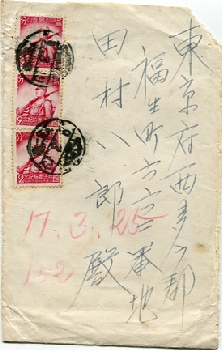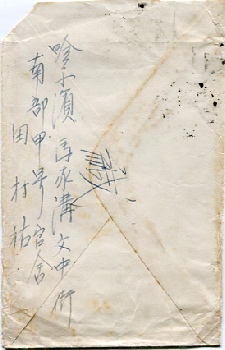
Cliquez sur les images pour agrandir -

LETTRE
19 mars 1942 -
–
March 19th, 1942 -


Ce courrier, d’apparence anodine, reflète de manière singulière l’histoire postale et humaine. La ville de destination Tungan (東 安 ) est la capitale de la province du même nom.
Auparavant, cette ville s’appelait Mishan (密 山 ). Il semble que le nom a été changé peu avant 1942 (1). Nous avons peut-
L’histoire humaine, elle, est sur la lettre de sept pages contenue dans l’enveloppe et malheureusement se ne sont pas de bonnes nouvelles.
Source:
( 1) ISJP Monograph 9 -
|
Dimensions : |
96 x 147 mm |
|
Size : |
96 x 147 mm |
|
|
Tarif : |
Lettre intérieur par 20 g………… |
6 fens |
Rate : |
Domestic letter per 20 g……….. |
6 fen |
|
Période de valeur : |
Du 01/03/1942 au 30/09/1944 |
|
Period of rate : |
03/01/1942 to 09/30/1944 |
|
|
Timbres utilisés : |
YT n°127 (bande de 3) |
|
Stamps : |
SG n°127 (slide of 3) |
|
|
Oblitération : |
N°41.1 Harbin 19/03/1942 |
|
Postmark : |
N°41.1 Harbin 03/19/1942 |
|
|
Période d’utilisation : |
Du 24/01/1936 au 13/06/1945 |
|
Period of use : |
01/24/1936 to 06/13/1945 |
|
|
Indications : |
Manuscrites au crayon rouge, date « 17.3.25 » en calendrier japonais et numéro « 152 » |
|
Instruction : |
Hanwritten with red pencil, date « 17.3.25 » in japanese calendar and number « 152 » |
|
|
Arrivée : |
25/03/1942 apposée à la main |
|
Arrival : |
Handwritten 03/25/1942 |
|
This seemingly innocuous letter is a unique reflection of postal and human history. The destination city Tungan (東 安 ) is the capital of the province of the same name.
It used to be called Mishan (密 山 ). It seems that the name was changed shortly before 1942 (1). Here we may have the explanation for the annotations in red pencil. Was the material (date stamp) missing? It seems unlikely, but when this letter arrived, the postman -
The human story is on the seven-
Source:
( 1) ISJP Monograph 9 -